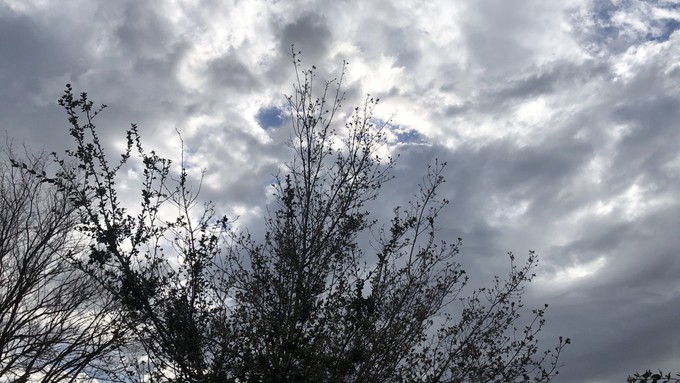
Be prepared; forecast calls for freezing temperatures and strong winds

So much for our sunny skies! Grey clouds and gusty winds have returned. Near-freezing temperatures, too. Kathy Morrison
Sacramento is about to get a double-dose of wintry weather: Intense cold and strong wind.
According to the National Weather Service, a storm front will create hazardous conditions Wednesday through Friday – including rare snowfall in the Sacramento Valley.
“Heavy low elevation snow with dangerous travel impacts expected tomorrow through Friday,” the Sacramento NWS tweeted Tuesday morning (Feb. 21). “Snow levels will fall to 1,000-2,000 feet tomorrow, with snow levels down to about 500 feet to the northern Sacramento Valley floor early Thursday morning and Thursday night to early Friday.”
Yes, snow is possible on the floor of the northern Sacramento Valley – and closer to home. Auburn, at 1,227 feet elevation and Placerville (elevation 1,867), definitely fall within the potential snow zone. But there’s a slight possibility flakes will fall as low as Roseville (elevation 164).
It’s not just the cold but the wind.
“Gusty winds will increase this afternoon over interior Northern California, slowly decreasing overnight,” the Sacramento NWS tweeted Tuesday. “Expect gusts 30 to 45 mph in the Valley and foothills and 40 to 70 mph over the mountains. Downed trees and branches, local power outages and difficult driving conditions are possible.”
In addition, overnight frost warnings are in the forecast Tuesday through Friday. Daytime highs will drop 20 degrees; the expected high on Thursday and Friday in Sacramento is only 48 degrees.
After several days of sunny, springlike weather, this downturn will be a shock to our plants, most of which already are in high-growth mode. Blooming fruit trees likely will lose their blossoms and may not set fruit. Expect to see some dieback on sprouting shrubs (such as roses). Newly transplanted vegetables or sprouting seeds are in danger of damping off.
What’s a gardener to do? Hold off on planting anything more until after this cold spree. Protect tender seedlings with row covers, milk cartons, water jugs or other shelter. Deep-water shrubs, trees and perennials; moist soil radiates heat and can raise the soil temperature (and surrounding space) just enough to prevent frost damage.
For more on freezing and frost, check out these recommendations from the UC Cooperative Extension master gardeners: https://ipm.ucanr.edu/PMG/GARDEN/ENVIRON/frostdamage.html.
Comments
0 comments have been posted.Sacramento Digs Gardening to your inbox.
Food in My Back Yard Series
April 29: What's (already) wrong with my tomato plants?
April 22: Should you stock up on fertilizer? (Yes!)
April 15: Grow culinary herbs in containers
April 8: When to plant summer vegetables
April 1: Don't be fooled by these garden myths
March 25: Fertilizer tips: How to 'feed' your vegetables for healthy growth
March 18: Time to give vegetable seedlings some more space
March 11: Ways to win the fight against weeds
March 4: Potatoes from the garden
Feb. 25: Plant a fruit tree now -- for later
Feb. 18: How to squeeze more food into less space
Feb. 11: When to plant? Consider staggering your transplants
Feb. 4: Starting in seed starting
Sites We Like
Garden Checklist for week of May 4
Enjoy this spring weather – and get gardening!
* Plant, plant, plant! It’s prime planting season in the Sacramento area. Time to set out those tomato transplants along with peppers and eggplants. Pinch off any flowers on new transplants to make them concentrate on establishing roots instead of setting premature fruit.
* Direct-seed melons, cucumbers, summer squash, corn, radishes, pumpkins and annual herbs such as basil.
* Harvest cabbage, lettuce, peas and green onions.
* In the flower garden, direct-seed sunflowers, cosmos, salvia, zinnias, marigolds, celosia and asters. (You also can transplant seedlings for many of the same flowers.)
* Plant dahlia tubers. Other perennials to set out include verbena, coreopsis, coneflower and astilbe.
* Transplant petunias, marigolds and perennial flowers such as astilbe, columbine, coneflowers, coreopsis, dahlias, rudbeckia and verbena.
* Keep an eye out for slugs, snails, earwigs and aphids that want to dine on tender new growth.
* Feed summer bloomers with a balanced fertilizer.
* For continued bloom, cut off spent flowers on roses as well as other flowering plants.
* Add mulch to the garden to maintain moisture. Mulch also cuts down on weeds. But don’t let it mound around the stems or trunks of trees or shrubs. Leave about a 6-inch to 1-foot circle to avoid crown rot or other problems.